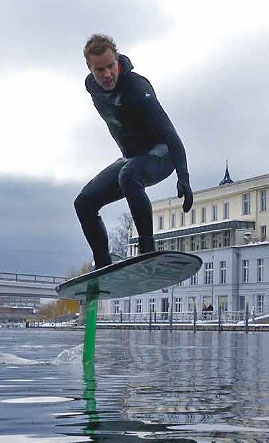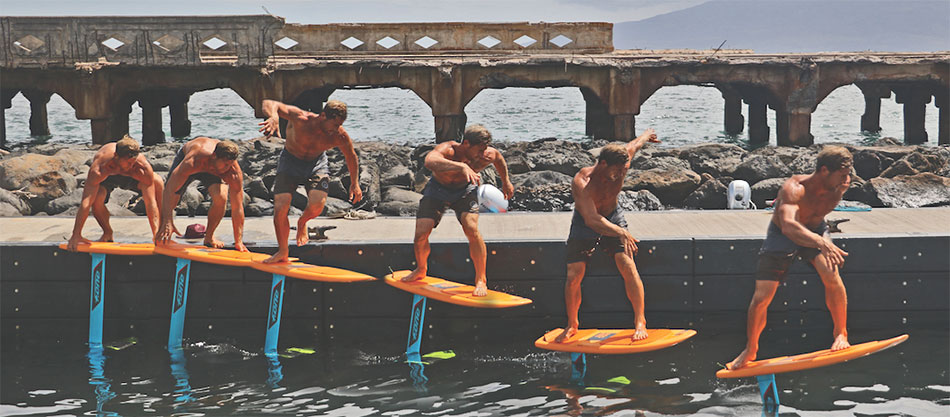What are the best ways to get on foil?
The trick to foiling is that you need a short burst of energy to take off. But if it doesn’t come from a wave or the wind, what does it come from?
Like an airplane, there are foils whose takeoff speed is extremely low. We’re seeing more and more creative people who don’t need wind and wave and come up with a system for getting that first burst of energy anyway.
Rope pulley: You stand on the board, your colleague pulls you briefly with a rope, as soon as you stand the pumping goes off. The whole thing also works with a bike or a winch.
Bungee: If you are alone, this is the easiest way. You anchor the rubber rope in the best a post in the water and create a pulley. When the rope is taut enough, you jump with the rope in your hand on the board in the water and off you go. Don’t forget to connect the end of the rubber rope with a normal rope so that you can pull it back on land for the next attempt. A pulley can also be very helpful.
SUP Paddle: It takes practice, but it works. With the right technique, you can paddle your way out of the water and get flying. It gets a little easier when you put the board in the water and take a running jump off a dock onto the board. Then you already have enough forward energy
The dockstart
With the dockstart, you just jump on your board and off you go. No rope or colleague to help, just you and your board. Dockstarting is also the most common launch technique to get started. You get to familiarize yourself with the foil at a very low speed. In addition, you learn the right way to fall right from the start. Even if you don’t get very far in the beginning, you immediately have a feeling for a good rhythm. The great thing is that you can practice this as long and as often as you want. You don’t depend on anything except finding a good spot on the shore. A jetty is perfect.
How to teach your self the dockstart?
Frank’s surf school teaches you the first steps. So what does the expert say:
“I have found that a jetty about 20-30 cm high is a good starting base for beginners. For the first few jumps, you hold the board just 30 cm above the surface of the water and just practice your aim: The back foot (usually) directly over the mast or slightly in front of it and the front foot nice and far forward. During the take-off, the weight must be shifted completely to the front. Try diving off the front of the board first to fall over the front of the board.”
The correct foot position, as Frank says, is very important. Previous sports experience is definitely very helpful when learning this technique. Then, when you land correctly, you start to find a pumping rhythm.
Frank again:
“On the next attempts, you then try to pull the board up again by pressing on the back foot just before diving. Once the first jumps are done, it becomes easier and easier to overcome and you feel the buoyancy more with each jump. Most of the time we manage to do the first 1-3 pump moves in the first class.
If you start alone, you need a few sessions more, because there are still many little tricks that can help individually. That’s simply also due to the prerequisites that everyone brings with them.”
How about learning behind a boat?
Frank:
“A boat can definitely bring some routine, but the waterstart swimming from deep water with a small board is very challenging for most beginners with no or little surfing experience and dependent on a sensitive boat driver. Those with a SUP foil are of course quicker at the boat, as you can launch standing up right away. The dock launch, however, is by far the coolest and most independent option. And, it’s a technique you have to work on anyway if you’re a landlocked surfer (as many of us are) and want to make quick progress with foils.”
“You also acquire important basics for SUP-foil, wing-foil, kite-foil and wing-foil. Because at 2Wave I offer the combination with the waves and a SUP-foil, participants come who would like to learn wing-foiling and have their first experience on a SUP-foil in the wave with me. Often they realize afterwards the potential from dock launching and the independent training possibilities. As casual as SUP foiling with wing looks with the pros, it’s just as difficult to learn for anyone who doesn’t live on the coast or on a big lake. So for those who really want to make good progress in all foiling sports and “only” have a river or smaller pond in the immediate vicinity, dock launching is a great way to conquer the world. If you have to. Pumpfoiling is just developing into a sport of its own that still has a lot of hidden potential.”
After the start

Once you have made the start, your goal is to stay in flight mode as long as possible. But that’s not so easy. Pump foiling is enormously strenuous and requires a good physical condition. With a well-developed technique and an efficient foil, a skilled foiler can cover long distances. Now we come back to the technical and want to write down a few rules of thumb for you:
Frank in Brandenburg in the middle of winter. Pumping keeps you warm.
Continue on the next page


